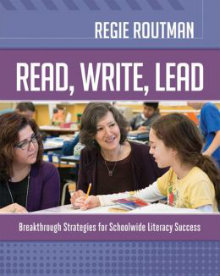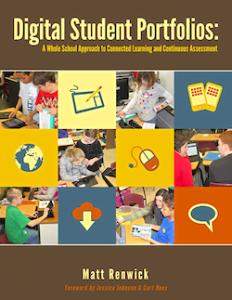Regie Routman Links Literacy and Leadership
Read, Write, Lead: Breakthrough Strategies for Schoolwide Literacy Success
By Regie Routman
(ASCD, 2014 – Learn more)
Reviewer Matt Renwick is a Wisconsin principal whose K-5 school has used Regie Routman’s professional development services. He notes that he was “a small contributor” to this book, including writing Appendix E: Recommended Technology Tools and Uses.
By Matt Renwick
Teachers must be leaders, and principals must know literacy.
When you read this line from the first page of Regie Routman’s new book, what is your initial reaction? Disagreement? Affirmation? Confusion? Regardless of your response, the author has come to this belief after working in schools for 45 years as a teacher, instructional coach, and now a staff developer.

The author highlights the connection between literacy and leadership, explains the role of assessment in responsive instruction, and provides leaders with a process for developing shared literacy beliefs. Routman also stresses the importance of great classroom instruction in order to prevent intervention down the road.
She closes out her text with specific strategies school leaders can use to create a community of lifelong learners, both individually and within PLCs (which Routman refers to as Professional Literacy Communities).
Three beliefs and misconceptions
So for a book at 300-plus pages, how does one write a succinct review for this encompassing educational resource? Instead of an equally comprehensive summary of each chapter, I would like to highlight three more beliefs that Regie Routman holds, preceded by misconceptions often held by educators.
Misconception #1: Teachers are the most important factor in student achievement.
What Routman Says: School leadership matters as much as teacher quality.
In her current role as a staff developer, Routman visits schools and districts in weeklong residencies. She has teachers watch her while she teaches their students, modeling the gradual release of responsibility. By the end of the week, the teachers have taken over. In her first forays into these residencies, she spent most of her time in the classroom. But when she came back to that same school a year later, not much had changed.
Routman realized that “without strong principal leadership, nothing much of significance happens related to improved schoolwide literacy achievement” (182). Now when she conducts a residency at a school, she spends just as much time with the principal, guiding them on how to conduct instructional walks and build trusting relationships with staff. She supports her assertion not only from her own experience leading schools to success, but also from educational change experts such as Dr. Douglas Reeves as well as prominent educators from Finland.
Misconception #2: Instruction should first be aligned with the standards.
What Routman Says: Instruction should first be aligned with the students.
The author questions the effectiveness of “Common Core-aligned” materials flooding the education market. Instead, she suggests we “put students before standards” (196). This means planning with our students’ needs in mind, using instructional strategies such as differentiation and public conferences. Great instruction will always be Common Core-aligned.

Regie Routman
This is not to suggest that Routman does not find the standards useful. For example, she appreciates how well the Common Core State Standards show educators a continuum of literacy expectations. The author also commends how the writers of the standards provide broader concepts that support the specific benchmarks at each grade level. But she does not recommend schools focus solely on outside expectations when developing building goals.
“Even when required curriculum, standards, procedures, and learning targets constrict us,” she writes, “our absolute first priority must be students’ optimal learning, well-being, success, and promising futures” (83).
Misconception #3: High expectations for teacher performance will improve schools.
What Routman Says: Shared beliefs and a culture built on trust will improve schools.
With such a large focus today on evaluation systems for both teachers and principals, educators may be experiencing some of the highest levels of stress in their careers. It doesn’t help that our profession is unfairly and routinely questioned by non-educators and agenda-driven politicians. So when lofty goals are put forth without the necessary support or resources, feelings of despair and in-house disagreements can result. This is not a recipe for success.
What the author believes, today and throughout her career as an educator, is that only a culture of trust that promotes common beliefs will put schools on the pathway toward continuous success. High expectations are certainly a part of this process; the difference is they are shared among the entire staff.
In fact, Routman asserts that developing organizational coherence and trusting relationships among the entire staff will increase a school’s capacity more quickly. “Although attitudes and beliefs change slowly, a culture of support and trust speeds up the process” (91). Which type of school environment would you rather teach in?
Read, Write, Lead could not have come out at a better time. Regie Routman brings some much needed sanity to the educational discussion that has become diluted by anyone with an opinion. An instructional leadership team would be wise to consider reading and discussing this essential resource that smartly connects literacy and leadership in the schoolhouse.

Matt blogs at Reading by Example, tweets @ReadByExample and writes for EdTech magazine. His book Digital Student Portfolios: A Whole School Approach to Connected Learning and Continuous Improvement was published in July 2014.


































